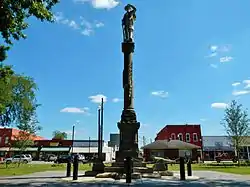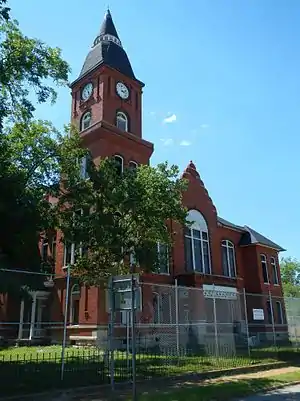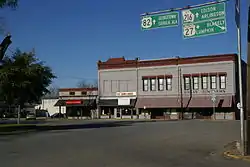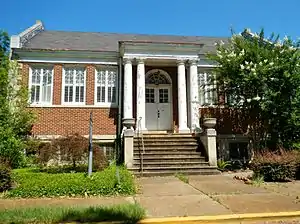Cuthbert, Georgia
Cuthbert is a city in, and the county seat of, Randolph County, Georgia, United States.[5] The population was 3,873 at the 2010 census.
Cuthbert, Georgia | |
|---|---|
 Cuthbert in 2012 | |
 Location in Randolph County and the state of Georgia | |
| Coordinates: 31°46′15″N 84°47′37″W | |
| Country | United States |
| State | Georgia |
| County | Randolph |
| Area | |
| • Total | 3.06 sq mi (7.92 km2) |
| • Land | 3.05 sq mi (7.89 km2) |
| • Water | 0.01 sq mi (0.04 km2) |
| Elevation | 466 ft (142 m) |
| Population (2010) | |
| • Total | 3,873 |
| • Estimate (2019)[2] | 3,417 |
| • Density | 1,121.80/sq mi (433.20/km2) |
| Time zone | UTC-5 (Eastern (EST)) |
| • Summer (DST) | UTC-4 (EDT) |
| ZIP codes | 31740, 39840 |
| Area code(s) | 229 |
| FIPS code | 13-21072[3] |
| GNIS feature ID | 0313227[4] |
History
Cuthbert was founded by European Americans in 1831 as seat of the newly formed Randolph County, after Indian Removal of the historic tribes to Indian Territory west of the Mississippi River. John Alfred Cuthbert, who represented Georgia in the U.S. House of Representatives from 1819 to 1821, is its namesake.[6][7] The county was developed for cotton plantations, the major commodity crop, and the rural area had a high proportion of enslaved African-American workers. Cuthbert was incorporated as a town in 1834 and as a city in 1859, serving as the trading center for the area. The Central of Georgia Railway arrived in Cuthbert in the 1850s, stimulating trade and growth, and providing a means of getting cotton and other crops to market.[8]
Geography
Cuthbert is located at 31º46'15" North, 84º47'37" West (31.770726, -84.793517).[9] The city is located along U.S. Route 27 and U.S. Route 82. U.S. Route 27 passes east of the city leading north 57 miles (92 km) to Columbus and south 112 miles (180 km) to Tallahassee, Florida. U.S. Route 82 passes through the heart of the city leading east 45 miles (72 km) to Albany and west 26 miles (42 km) to Eufaula, Alabama. Other highways that pass through the city include Georgia State Route 266 and Georgia State Route 216.
According to the United States Census Bureau, the city has a total area of 3.0 square miles (7.8 km2), all land.
Demographics
| Historical population | |||
|---|---|---|---|
| Census | Pop. | %± | |
| 1870 | 2,210 | — | |
| 1880 | 2,129 | −3.7% | |
| 1890 | 2,328 | 9.3% | |
| 1900 | 2,641 | 13.4% | |
| 1910 | 3,210 | 21.5% | |
| 1920 | 3,022 | −5.9% | |
| 1930 | 3,235 | 7.0% | |
| 1940 | 3,447 | 6.6% | |
| 1950 | 4,025 | 16.8% | |
| 1960 | 4,300 | 6.8% | |
| 1970 | 3,972 | −7.6% | |
| 1980 | 4,340 | 9.3% | |
| 1990 | 3,730 | −14.1% | |
| 2000 | 3,731 | 0.0% | |
| 2010 | 3,873 | 3.8% | |
| 2019 (est.) | 3,417 | [2] | −11.8% |
| U.S. Decennial Census[10] | |||

As of the census[3] of 2000, there were 3,731 people, 1,360 households, and 870 families residing in the city. The population density was 1,223.5 people per square mile (472.3/km2). There were 1,549 housing units at an average density of 507.9 per square mile (196.1/km2). The "racial" makeup of the city was 74.22% African American, 23.69% White, 0.32% Native American, 0.32% Asian, 0.11% Pacific Islander, 0.88% from other races, and 0.46% from two or more races. 1.96% of the population were Hispanic or Latino of any race.
There were 1,360 households, out of which 29.8% had children under the age of 18 living with them, 30.7% were married couples living together, 29.4% had a female householder with no husband present, and 36.0% were non-families. 33.8% of all households were made up of individuals, and 16.5% had someone living alone who was 65 years of age or older. The average household size was 2.52 and the average family size was 3.24.
In the city, the population was spread out, with 26.7% under the age of 18, 14.8% from 18 to 24, 23.2% from 25 to 44, 19.2% from 45 to 64, and 16.1% who were 65 years of age or older. The median age was 34 years. For every 100 females, there were 80.2 males. For every 100 females age 18 and over, there were 71.6 males.
The median income for a household in the city was $16,400, and the median income for a family was $25,000. Males had a median income of $26,696 versus $16,976 for females. The per capita income for the city was $10,166. 33.5% of the population and 29.2% of families were below the poverty line, including 39.8% of those under the age of 18 and 38.5% of those 65 and older.
Culture and historic district
Cuthbert is home to Andrew College (formerly Andrew Female College), a two-year private liberal arts college. The Fletcher Henderson Museum is being established in Cuthbert in honor of the 20th-century jazz musician and orchestra arranger.
The city has notable sites such as a Confederate Army cemetery, historical houses built in the 1800s, and the Fletcher Henderson home. In 2007 an announcement was made of a museum to be dedicated to late resident Lena Baker and issues of racial justice. Baker was an African-American maid who was convicted of capital murder in 1945 in the death of a white man; she was the only woman in Georgia to be executed by electric chair. She had claimed self-defense, and in 2005 the state posthumously pardoned her.[11] She was the subject of a 2001 biography and a 2008 feature film of the same name, The Lena Baker Story. (It was later retitled Hope and Redemption: The Lena Baker Story.)
Education
The Randolph County School District holds grades pre-school to grade twelve, and consists of two elementary, middle, and high schools.[12] The district has 88 full-time teachers and more than 1,530 students.[13]
- Randolph County Elementary School
- Randolph Clay High School
- Albany Technical College
Higher education
- Andrew College - Main Campus[14]
- Albany Technical College - Cuthbert campus
Notable people
- Lena Baker, the only woman executed in the electric chair in Georgia; she was later pardoned by the state
- Jerry Braswell Jr., former European professional basketball player and Wake Forest Demon Deacon
- Thomas Davis, NFL player, former UGA football player
- Harris DeVane, former stock car racing driver
- Roosevelt Grier, former NFL player
- Franklin A. Hart, four-star general in the United States Marine Corps
- Donnell Harvey, former NBA player, former University of Florida player
- Fletcher Henderson, jazz musician
- Larry Holmes, former world heavyweight boxing champion
- Joe, R&B singer and record producer
- Winfred Rembert, leather-craft artist famous for surviving a lynching in Cuthbert[15][16]
- George Tyler Wood, second governor of Texas[17]
- Richard R. Wright Jr., sociologist and president of Wilberforce University.
Gallery
 Built in 1886 in the Romanesque Revival style, the Randolph County Courthouse has been placed on the Georgia Trust for Historic Preservation's list of "Places in Peril" for 2012 due to extensive termite damage and general disrepair.
Built in 1886 in the Romanesque Revival style, the Randolph County Courthouse has been placed on the Georgia Trust for Historic Preservation's list of "Places in Peril" for 2012 due to extensive termite damage and general disrepair. Cuthbert is the site of Andrew College, a private, Methodist, liberal arts junior college located a few blocks off the town square. The college is the ninth-oldest college in Georgia and is recognized as the second in the nation to grant degrees to women. During the Civil War, the college also distinguished itself as a Confederate hospital.
Cuthbert is the site of Andrew College, a private, Methodist, liberal arts junior college located a few blocks off the town square. The college is the ninth-oldest college in Georgia and is recognized as the second in the nation to grant degrees to women. During the Civil War, the college also distinguished itself as a Confederate hospital..JPG.webp) Cuthbert is the birthplace of jazz legend Fletcher Henderson. His birthplace was added to the National Register of Historic Places on June 17, 1982.
Cuthbert is the birthplace of jazz legend Fletcher Henderson. His birthplace was added to the National Register of Historic Places on June 17, 1982. Cuthbert's Main Square is part of the Cuthbert Historic District which was added to the National Register of Historic Places on June 10, 1975.
Cuthbert's Main Square is part of the Cuthbert Historic District which was added to the National Register of Historic Places on June 10, 1975. Cuthbert City Hall
Cuthbert City Hall.JPG.webp) Cuthbert Post Office (ZIP code:39840)
Cuthbert Post Office (ZIP code:39840) The Old Carnegie library was completed in 1918 and was originally used by the Kinchafoonee Regional Library System. The building is now used by the Randolph Chamber of Commerce.
The Old Carnegie library was completed in 1918 and was originally used by the Kinchafoonee Regional Library System. The building is now used by the Randolph Chamber of Commerce. Close-up of the statue honoring Confederate dead in Cuthbert's Main Square.
Close-up of the statue honoring Confederate dead in Cuthbert's Main Square. Water tower in Cuthbert.
Water tower in Cuthbert.
References
- "2019 U.S. Gazetteer Files". United States Census Bureau. Retrieved July 9, 2020.
- "Population and Housing Unit Estimates". United States Census Bureau. May 24, 2020. Retrieved May 27, 2020.
- "U.S. Census website". United States Census Bureau. Retrieved 2008-01-31.
- "US Board on Geographic Names". United States Geological Survey. 2007-10-25. Retrieved 2008-01-31.
- "Find a County". National Association of Counties. Archived from the original on 2011-05-31. Retrieved 2011-06-07.
- Krakow, Kenneth K. (1975). Georgia Place-Names: Their History and Origins (PDF). Macon, GA: Winship Press. p. 56. ISBN 0-915430-00-2.
- Gannett, Henry (1905). The Origin of Certain Place Names in the United States. Govt. Print. Off. pp. 98.
- Hellmann, Paul T. (May 13, 2013). Historical Gazetteer of the United States. Routledge. p. 226. ISBN 978-1135948597. Retrieved 30 November 2013.
- "US Gazetteer files: 2010, 2000, and 1990". United States Census Bureau. 2011-02-12. Retrieved 2011-04-23.
- "Census of Population and Housing". Census.gov. Retrieved June 4, 2015.
- "Big Band News", Big Band Library: July 2007
- Georgia Board of Education, Retrieved June 26, 2010.
- School Stats, Retrieved June 26, 2010.
- Andrew College, Retrieved June 26, 2010.
- "Nearly lynched in the 1960s, New Haven man uses art to teach others about the past". FOX 61. 2017-03-02. Retrieved 2019-06-29.
- "The Indelible Images of Winfred Rembert | The Folk Art Society of America". folkart.org. Retrieved 2019-06-29.
- "Texas Governor George T. Wood". National Governors Association. Retrieved November 2013. Check date values in:
|access-date=(help)
External links
- South Georgia Historic Newspapers Archive, Digital Library of Georgia
- The Southern Tribune, office in Cuthbert, GA, local newspaper serving the southwest Georgia counties of Calhoun, Clay, Randolph, and Quitman
 Media related to Cuthbert, Georgia at Wikimedia Commons
Media related to Cuthbert, Georgia at Wikimedia Commons
